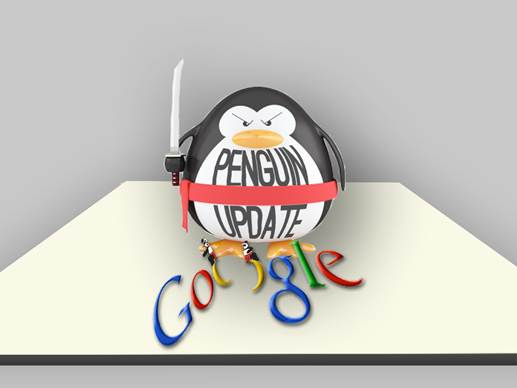It's that time again. After a long series of mini updates for Penguin 1.0, the newest version, referred to by Matt Cutts as Penguin 2.0 will be implemented into Google's algorithm. The new update was just announced by Matt Cutts on May 22nd, so we don't know exactly what changed yet. However, based on what Cutts has said leading up to the update, as well as what we learned from Penguin 1.0, we can make some likely assumptions. Please note that what follows is solely my best guess at what Google has changed with Penguin 2.0, and how to recover. New data may be revealed as tests get underway that changes the SEO community's collective knowledge.
Ever since the first Penguin turned the SEO world on its head, any major changes are often met with anxiety and even dread by many webmasters. If your website has felt the backlash and there's been a noticeable drop in rankings, don't panic. Fortunately, there are several steps that can be taken to recover and get back on track.

The Basics
According to Matt Cutts, the new version of Penguin is primarily designed to penalize websites that utilize black hat SEO techniques and reward websites that offer genuine value. Webmasters who create content that people naturally want to share and websites that visitors want to explore and return to shouldn't be affected negatively. He also stated that Penguin 2.0 should help many small to mid-sized businesses that play by the rules and avoid black hat SEO. It should also help authority sites gain traction while decreasing the rankings of sites that merely provide generic fluff.
The ultimate goal is to cut back on link spamming and hacking, while providing webmasters with the tools to fix hacked sites. Since "cluster results," where a cluster of results from the same website have been somewhat of a problem, they have also addressed this issue. Consequently, search results should be more balanced where one particular site doesn't dominate the first page of a search term.
They are also targeting certain search queries that have a reputation for being affiliated with spam (for example, "payday loans"). Sites that go overboard with advertisements or try to sneak them in under the nose of visitors may also be penalized.
In reality, it doesn't appear that Google is reinventing the SEO wheel with Penguin 2.0, but simply tightening their algorithm to provide users with the most high-quality and relevant content possible. Of course, this isn't fool-proof and some legitimate webmasters may get caught in the crossfire.
Here are some factors to consider when building links in the new, Penguin 2.0 environment.
Link Value
Although it's helpful to have a large volume of links, it won't do much good if they're from "bad neighborhoods." That's why it's so important to focus on acquiring links from reputable sites. One great way to do this is via guest blogging. As long as the vast majority of links are from trusted sites, they should act as a shield that protects from future updates.
Otherwise, an abundance of links from bad neighborhoods that use manipulative techniques can have a negative impact. If you're unsure of a website's credibility, use as tool like PR Checker. This simple tool will quickly display a domain's page rank. Websites with a page rank of 4 or higher are generally suitable for backlinks, but the higher the better.
However, Page Rank isn't always fool-proof. It's best to look at the content on the website and evaluate how useful, relevant, and interesting it is. Also, check the website's social channels like Facebook and Twitter, and see how many followers they have in each. A higher follower count is generally a good indication of quality and credibility.
Link Velocity
Another issue that Google has addressed is the rate at which a site acquires links. Except for a few select cases with viral implications, they know that quality sites usually accumulate links organically and gradually over time. If a newer website suddenly experiences spikes where numerous links are acquired over night, this serves as a red flag to Google, making it more likely the site will get "sandboxed." Search Engine Watch demonstrated this phenomenon on a line graph where any more than 75 links a day were ignored by Google.
For this reason, it's best to be somewhat conservative in a link building campaign and not create huge quantities at one time. Instead, it's better to space them out over time in a more natural manner. Basically, the velocity should be consistent or increase slightly over time.
Avoid Exact-Match Anchor Text
After analyzing a ton of data, Google and most SEO professionals have recognized the correlation between exact match anchor text and web spam. Accordingly, they have taken measures to penalize sites that have excessive links with exact match keywords in the anchor text. Since this is likely to keep tightening in the future, it's smart to keep this practice to a minimum. If your site has an excessive amount of links with exact match keywords in anchor texts, it's a good idea to edit those keywords so that they are not exact matches.
Instead, use sentence fragments and branded anchors. I recently wrote an overview of all the different types of anchor text, along with an analysis of each one and recommendations for how to properly use anchor text in a Penguin 2.0 environment.
Link Relevancy
As most webmasters with basic SEO knowledge already know, relevancy plays a big role in link quality. Links from completely irrelevant sites can hurt a site's rankings (or, at best, provide negligible value), while links from highly relevant sites should help as long as they're reputable. If you've been accumulating links from a hodgepodge of sites that have nothing to do with your industry, this could account for a decrease in rankings from Penguin 2.0. Keep this in mind in future SEO campaigns.
Here are some ways to improve your rankings if you've been adversely affected by Penguin 2.0.
Step 1. Understand Your Link Profile
Step 1. Understand Your Link Profile
One of the most effective ways to recover from Penguin 2.0 and protect yourself from future issues is to have a full understanding of your link profile. Start with a link profile audit to identify bad links which could have caused your website to get hit by Penguin 2.0. If you're the do-it-yourself type, try data tracking tools like Majestic SEO and Open Site Explorer.
These platforms are designed to create an in-depth picture of your link profile. Some common features include backlink reports, inbound link analysis and daily rank tracking. While this wasn't all that necessary a short while ago, these tools are becoming more and more important. After understanding your link profile, you can take the necessary steps to solve any problem areas.
Step 2. Run Backlink Checks on Sites Linking to You
Step 2. Run Backlink Checks on Sites Linking to You
In addition to checking the backlinks of your website, it's a good idea to investigate the primary sites that link back to you. This can also be done via Majestic SEO, but there are other tools like Backlink Watch and Analyze Backlinks that are also effective. This is important because if a particular site is getting links from bad neighborhoods, it will lower their link equity. In turn, this can have a negative impact on your SEO. If you find a site with poor link equity, backlinks from this site should be removed.
Step 3. Remove and Disavow Harmful Links
By all accounts, the consensus is that a website can recover and improve its ranking in time through the removal and/or disavowal of bad inbound links. Since Google's algorithm will eventually re-crawl and re-index content, a website can reclaim its position in the rankings, in most cases. While this process is usually frustrating and often time-consuming, it's necessary to get rankings back on track and climb the SEO ladder once again.
But the question is, how do you know which links to remove or disavow? You can either get assistance from a professional SEO firm to analyze your link profile and provide a spreadsheet of which links to remove, or you can try following this step-by-step guide.
Step 4. Build New, High-Quality Inbound Links
If you've been hit by Penguin 2.0, the best way to prove to Google that your website belongs in the rankings is by getting other credible, high-quality websites that Google trusts to vouch for you. You can do this by getting inbound links from these websites. There are lots of ways to ethically build high-quality, powerful links, but my favorite is through guest blogging. If guest blogging isn't an option, then here are 8 other ways to build links.
Conclusion
Penguin 2.0 is a tightening of the algorithm Google originally launched back in April of 2012. The principles are the same, as are the goals Google is trying to achieve with the release of the next iteration of it. If you've been hit by Penguin 2.0, follow the steps above to recover from it, and be sure to tread carefully as you move forward with your SEO initiative. Don't go for the short-term gain if it sacrifices your brand in the long-term. Otherwise, Penguin will be making a very unpleasant visit to your website.







